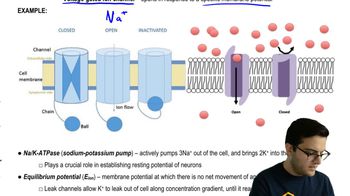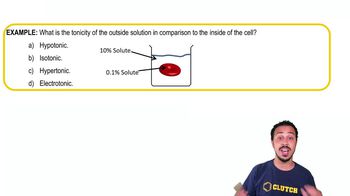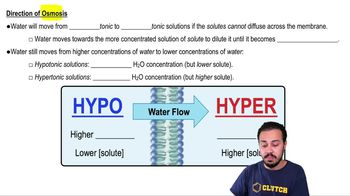Table of contents
- 1. Introduction to Biology2h 42m
- 2. Chemistry3h 40m
- 3. Water1h 26m
- 4. Biomolecules2h 23m
- 5. Cell Components2h 26m
- 6. The Membrane2h 31m
- 7. Energy and Metabolism2h 0m
- 8. Respiration2h 40m
- 9. Photosynthesis2h 49m
- 10. Cell Signaling59m
- 11. Cell Division2h 47m
- 12. Meiosis2h 0m
- 13. Mendelian Genetics4h 44m
- Introduction to Mendel's Experiments7m
- Genotype vs. Phenotype17m
- Punnett Squares13m
- Mendel's Experiments26m
- Mendel's Laws18m
- Monohybrid Crosses19m
- Test Crosses14m
- Dihybrid Crosses20m
- Punnett Square Probability26m
- Incomplete Dominance vs. Codominance20m
- Epistasis7m
- Non-Mendelian Genetics12m
- Pedigrees6m
- Autosomal Inheritance21m
- Sex-Linked Inheritance43m
- X-Inactivation9m
- 14. DNA Synthesis2h 27m
- 15. Gene Expression3h 20m
- 16. Regulation of Expression3h 31m
- Introduction to Regulation of Gene Expression13m
- Prokaryotic Gene Regulation via Operons27m
- The Lac Operon21m
- Glucose's Impact on Lac Operon25m
- The Trp Operon20m
- Review of the Lac Operon & Trp Operon11m
- Introduction to Eukaryotic Gene Regulation9m
- Eukaryotic Chromatin Modifications16m
- Eukaryotic Transcriptional Control22m
- Eukaryotic Post-Transcriptional Regulation28m
- Eukaryotic Post-Translational Regulation13m
- 17. Viruses37m
- 18. Biotechnology2h 58m
- 19. Genomics17m
- 20. Development1h 5m
- 21. Evolution3h 1m
- 22. Evolution of Populations3h 52m
- 23. Speciation1h 37m
- 24. History of Life on Earth2h 6m
- 25. Phylogeny2h 31m
- 26. Prokaryotes4h 59m
- 27. Protists1h 12m
- 28. Plants1h 22m
- 29. Fungi36m
- 30. Overview of Animals34m
- 31. Invertebrates1h 2m
- 32. Vertebrates50m
- 33. Plant Anatomy1h 3m
- 34. Vascular Plant Transport1h 2m
- 35. Soil37m
- 36. Plant Reproduction47m
- 37. Plant Sensation and Response1h 9m
- 38. Animal Form and Function1h 19m
- 39. Digestive System1h 10m
- 40. Circulatory System1h 57m
- 41. Immune System1h 12m
- 42. Osmoregulation and Excretion50m
- 43. Endocrine System1h 4m
- 44. Animal Reproduction1h 2m
- 45. Nervous System1h 55m
- 46. Sensory Systems46m
- 47. Muscle Systems23m
- 48. Ecology3h 11m
- Introduction to Ecology20m
- Biogeography14m
- Earth's Climate Patterns50m
- Introduction to Terrestrial Biomes10m
- Terrestrial Biomes: Near Equator13m
- Terrestrial Biomes: Temperate Regions10m
- Terrestrial Biomes: Northern Regions15m
- Introduction to Aquatic Biomes27m
- Freshwater Aquatic Biomes14m
- Marine Aquatic Biomes13m
- 49. Animal Behavior28m
- 50. Population Ecology3h 41m
- Introduction to Population Ecology28m
- Population Sampling Methods23m
- Life History12m
- Population Demography17m
- Factors Limiting Population Growth14m
- Introduction to Population Growth Models22m
- Linear Population Growth6m
- Exponential Population Growth29m
- Logistic Population Growth32m
- r/K Selection10m
- The Human Population22m
- 51. Community Ecology2h 46m
- Introduction to Community Ecology2m
- Introduction to Community Interactions9m
- Community Interactions: Competition (-/-)38m
- Community Interactions: Exploitation (+/-)23m
- Community Interactions: Mutualism (+/+) & Commensalism (+/0)9m
- Community Structure35m
- Community Dynamics26m
- Geographic Impact on Communities21m
- 52. Ecosystems2h 36m
- 53. Conservation Biology24m
6. The Membrane
Osmosis
Problem 9`
Textbook Question
In an experiment, you create two groups of liposomes in a solution containing 0.1 M NaCl—one made from red blood cell membranes and the other from frog egg cell membranes. When the liposomes are placed in water, those with red blood cell membranes burst more rapidly than those made from egg membranes. What could explain these results? Select True or False for each of the following statements.
a. T/F The red blood cell liposomes are more hypertonic relative to water than the frog egg liposomes.
b. T/F The red blood cell liposomes are more hypotonic relative to water than the frog egg liposomes.
c. T/F The red blood cell liposomes contain more aquaporins than the frog egg liposomes.
d. T/F The frog egg liposomes contain ion channels, which are not present in the red blood cell liposomes.
 Verified step by step guidance
Verified step by step guidance1
Step 1: Understand the concept of tonicity. Tonicity refers to the relative concentration of solutes in two solutions separated by a semipermeable membrane. A hypertonic solution has a higher concentration of solutes compared to another solution, while a hypotonic solution has a lower concentration.
Step 2: Analyze statement a. Consider whether the red blood cell liposomes are more hypertonic relative to water than the frog egg liposomes. If the red blood cell liposomes burst more rapidly, it suggests they might be more hypertonic, causing water to rush in and burst them.
Step 3: Analyze statement b. Consider whether the red blood cell liposomes are more hypotonic relative to water than the frog egg liposomes. If they were hypotonic, water would move out, which is less likely to cause bursting.
Step 4: Analyze statement c. Consider the role of aquaporins, which are water channels that facilitate the rapid movement of water across cell membranes. If red blood cell liposomes contain more aquaporins, it could explain the rapid influx of water and bursting.
Step 5: Analyze statement d. Consider the presence of ion channels in frog egg liposomes. Ion channels allow ions to pass through the membrane, potentially affecting osmotic balance differently than aquaporins. If frog egg liposomes have ion channels, it might explain their slower bursting rate compared to red blood cell liposomes.
 Verified video answer for a similar problem:
Verified video answer for a similar problem:This video solution was recommended by our tutors as helpful for the problem above
Video duration:
2mPlay a video:
Was this helpful?
Key Concepts
Here are the essential concepts you must grasp in order to answer the question correctly.
Osmosis and Tonicity
Osmosis is the movement of water across a semipermeable membrane from a region of lower solute concentration to a region of higher solute concentration. Tonicity refers to the relative concentration of solutes outside the cell compared to inside, affecting water movement. A hypertonic solution has a higher solute concentration outside, causing water to leave the cell, while a hypotonic solution has a lower solute concentration outside, causing water to enter the cell.
Recommended video:
Guided course

Osmosis
Membrane Composition and Permeability
Cell membranes are composed of a lipid bilayer with embedded proteins, which determine the membrane's permeability to various substances. The presence of specific proteins, such as aquaporins, can increase water permeability. Differences in membrane composition between red blood cells and frog egg cells can affect how quickly water moves across the membrane, influencing the rate at which liposomes burst in hypotonic conditions.
Recommended video:
Guided course

Introduction to Membrane Transport
Aquaporins and Ion Channels
Aquaporins are membrane proteins that facilitate rapid water transport across cell membranes, significantly affecting osmosis. Ion channels, on the other hand, allow the passage of ions and can influence the cell's osmotic balance. The presence or absence of these proteins in liposomes can explain differences in their behavior when placed in water, as they alter the rate of water influx or efflux, impacting the stability of the liposomes.
Recommended video:
Guided course

Ion Channels and Pumps
Related Videos
Related Practice














